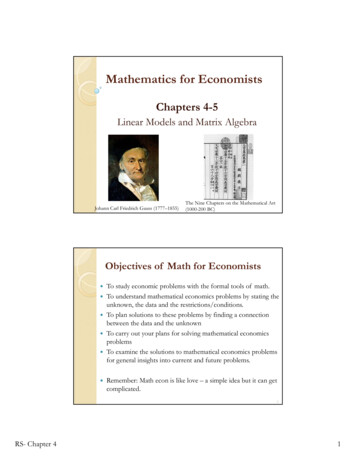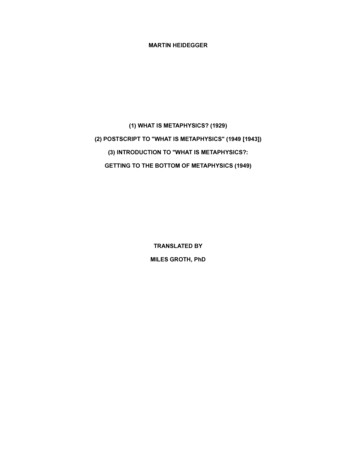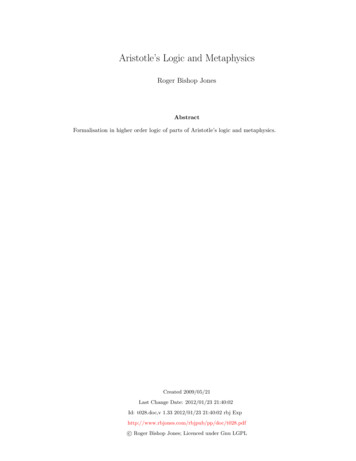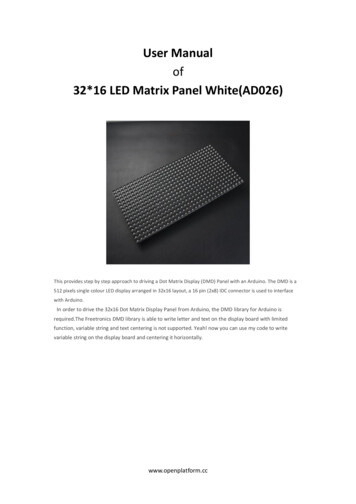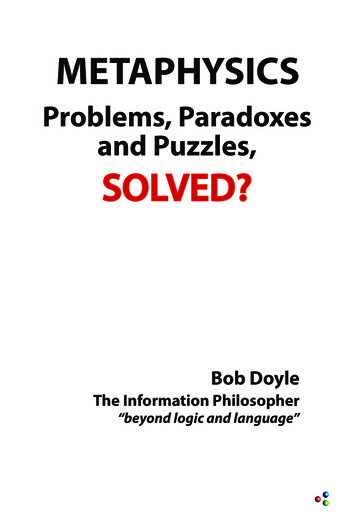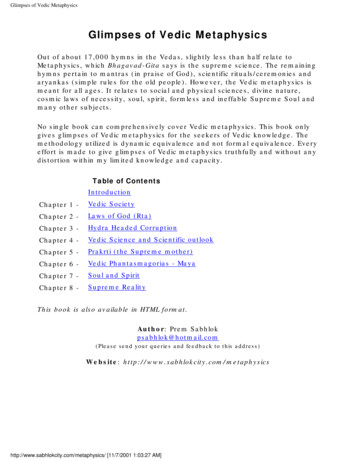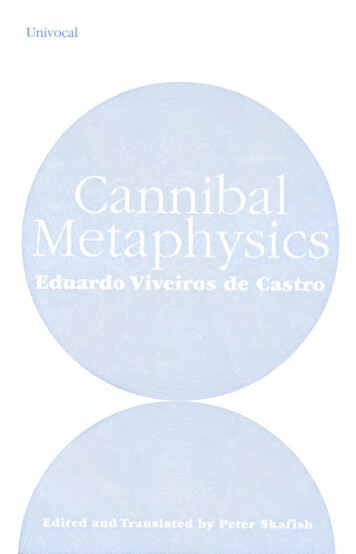
Transcription
The Matrix as MetaphysicsDavid J. ChalmersPhilosophy ProgramResearch School of Social SciencesAustralian National University1Brains in VatsThe Matrix presents a version of an oldphilosophical fable: the brain in a vat. A disembodiedbrain is floating in a vat, inside a scientist’s laboratory.The scientist has arranged that the brain will bestimulated with the same sort of inputs that a normalembodied brain receives. To do this, the brain isconnected to a giant computer simulation of a world.The simulation determines which inputs the brainreceives. When the brain produces outputs, these are fedback into the simulation. The internal state of the brain is just like that of a normal brain,despite the fact that it lacks a body. From the brain’s point of view, things seem very much asthey seem to you and me.The brain is massively deluded, it seems. It has all sorts of false beliefs about the world.It believes that it has a body, but it has no body. It believes that it is walking outside in thesunlight, but in fact it is inside a dark lab. It believes it is one place, when in fact it may besomewhere quite different. Perhaps it thinks it is in Tucson, when it is actually in Australia, oreven in outer space.Neo’s situation at the beginning of The Matrix is something like this. He thinks that helives in a city; he thinks that he has hair; he thinks it is 1999; and he thinks that it is sunnyoutside. In reality, he is floating in a pod in space; he has no hair; the year is around 2199; andThis paper was written for the “philosophy section” of the official Matrix website. It also appears in C. Grau, ed,Philosophers Explore the Matrix, Oxford University Press, 2005. As such, the bulk of the paper is written to beaccessible for an audience without a background in philosophy. At the same time, this paper is intended as aserious work of philosophy, with relevance for central issues in epistemology, metaphysics, and the philosophyof mind and language. A section of “philosophical notes” at the end of the article draws out some of theseconnections explicitly.1
the world has been darkened by war. There are a few small differences from the vat scenarioabove: Neo’s brain is located in a body, and the computer simulation is controlled bymachines rather than by a scientist. But the essential details are much the same. In effect, Neois a brain in a vat.Let’s say that a matrix (lower-case m) is an artificially designed computer simulation of aworld. So the Matrix in the movie is one example of a matrix. And let’s say that someone isenvatted, or that they are in a matrix, if they have a cognitive system which receives its inputsfrom and sends its outputs to a matrix. Then the brain at the beginning is envatted and sois Neo.We can imagine that a matrix simulates the entire physics of a world, keeping track ofevery last particle throughout space and time. (Later, we will look at ways in which this setup might be varied.) An envatted being will be associated with a particular simulated body. Aconnection is arranged so that whenever this body receives sensory inputs inside thesimulation, the envatted cognitive system will receive sensory inputs of the same sort. Whenthe envatted cognitive system produces motor outputs, corresponding outputs will be fed tothe motor organs of the simulated body.When the possibility of a matrix is raised, a question immediately follows: how do Iknow that I am not in a matrix? After all, there could be a brain in a vat structured exactly likemy brain, hooked up to a matrix, with experiences indistinguishable from those I am havingnow. From the inside, there is no way to tell for sure that I am not in the situation of the brainin a vat. So it seems that there is no way to know for sure that I am not in a matrix.Let us call the hypothesis that I am in a matrix and have always been in a matrix theMatrix Hypothesis. Equivalently, the Matrix Hypothesis says that I am envatted and havealways been envatted. This is not quite equivalent to the hypothesis that I am in the Matrix, asthe Matrix is just one specific version of a matrix. For now, I will ignore some complicationsthat are specific to the Matrix in the movie, such as the fact that people sometimes travel backand forth between the Matrix and the external world. These issues aside, we can think of theMatrix Hypothesis informally as saying that I am in the same sort of situation as people whohave always been in the Matrix.The Matrix Hypothesis is one that we should take seriously. As Nick Bostrom hassuggested, it is not out of the question that in the history of the universe, technology willevolve that will allow beings to create computer simulations of entire worlds. There may wellbe vast numbers of such computer simulations, compared to just one real world. If so, theremay well be many more beings who are in a matrix than beings who are not. Given all this,one might even infer that it is more likely that we are in a matrix than that we are not.2
Whether this is right or not, it certainly seems that we cannot be certain that we are not in amatrix.Serious consequences seem to follow. My envatted counterpart seems to be massivelydeluded. It thinks it is in Tucson; it thinks it is sitting at a desk writing an article; it thinks ithas a body. On the face of it, all of these beliefs are false. Likewise, it seems that if I amenvatted, my own corresponding beliefs are false. If I am envatted, I am not really in Tucson;I am not really sitting at a desk; and I may not even have a body. So if I don’t know that I amnot envatted, then I don’t know that I am in Tucson; I don’t know that I am sitting at a desk;and I don’t know that I have a body.The Matrix Hypothesis threatens to undercut almost everything I know. It seems to be askeptical hypothesis: a hypothesis that I cannot rule out, and one that would falsify most ofmy beliefs if it were true. Where there is a skeptical hypothesis, it looks like none of thesebeliefs count as genuine knowledge. Of course the beliefs might be true—I might be lucky,and not be envatted—but I can’t rule out the possibility that they are false. So a skepticalhypothesis leads to skepticism about these beliefs: I believe these things, but I do not knowthem.To sum up the reasoning: I don’t know that I’m not in a matrix. If I’m in a matrix,I’m probably not in Tucson. So if I don’t know that I’m not in a matrix, then I don’t knowthat I’m in Tucson. The same goes for almost everything else I think I know about theexternal world.2Envatment ReconsideredThis is a standard way of thinking about the vat scenario. It seems that this view is alsoendorsed by the people who created The Matrix. On the DVD case for the movie, one sees thefollowing:Perception: Our day-in, day-out world is real.Reality: That world is a hoax, an elaborate deception spun by all-powerful machines thatcontrol us. Whoa.I think this view is not quite right. I think that even if I am in a matrix, my world isperfectly real. A brain in a vat is not massively deluded (at least if it has always been in thevat). Neo does not have massively false beliefs about the external world. Instead, envattedbeings have largely correct beliefs about their world. If so, the Matrix Hypothesis is not askeptical hypothesis, and its possibility does not undercut everything that I think I know.3
Philosophers have held this sort of view before. The eighteenth-century philosopherGeorge Berkeley held, in effect, that appearance is reality. (Recall Morpheus: “What is ‘real’?How do you define ‘real’? If you’re talking about what you can feel, what you can smell,what you can taste and see, then real is simply electrical signals interpreted by your brain.”) Ifthis is right, then the world perceived by envatted beings is perfectly real: these beingsexperience all the right appearances, and appearance is reality. So on this view, even envattedbeings have true beliefs about the world.I have recently found myself embracing a similar conclusion, though for quite differentreasons. I don’t find the view that appearance is reality plausible, so I don’t endorseBerkeley’s reasoning. And until recently, it has seemed quite obvious to me that brains in vatswould have massively false beliefs. But I now think there is a line of reasoning that showsthat this is wrong.I still think I cannot rule out the hypothesis that I am in a matrix. But I think that even if Iam in a matrix, I am still in Tucson; I am still sitting at my desk; and so on. So the hypothesisthat I am in a matrix is not a skeptical hypothesis. The same goes for Neo. At the beginning ofthe film, if he thinks “I have hair”, he is correct. If he thinks “It is sunny outside”, he iscorrect. And the same goes, of course, for the original brain in a vat. When it thinks, “I have abody”, it is correct. When it thinks, “I am walking”, it is correct.This view may seem counterintuitive at first. Initially, it seemed quite counterintuitive tome. So I’ll now present the line of reasoning that has convinced me that it is correct.3The Metaphysical HypothesisI will argue that the hypothesis that I am envatted is not a skeptical hypothesis, but ametaphysical hypothesis. That is, it is a hypothesis about the underlying nature of reality.Where physics is concerned with the microscopic processes that underlie macroscopicreality, metaphysics is concerned with the fundamental nature of reality. A metaphysicalhypothesis might make a claim about the reality that underlies physics itself. Alternatively, itmight say something about the nature of our minds, or the creation of our world.I think that the Matrix Hypothesis should be regarded as a metaphysical hypothesis withall three of these elements. It makes a claim about the reality underlying physics, about thenature of our minds, and about the creation of the world.In particular, I think the Matrix Hypothesis is equivalent to a version of the followingthree-part Metaphysical Hypothesis. First, physical processes are fundamentallycomputational. Second, our cognitive systems are separate from physical processes, but4
interact with these processes. Third, physical reality was created by beings outside physicalspace-time.Importantly, nothing about this Metaphysical Hypothesis is skeptical. The MetaphysicalHypothesis here tells us about the processes underlying our ordinary reality, but it does notentail that this reality does not exist. We still have bodies, and there are still chairs and tables:it’s just that their fundamental nature is a bit different from what we may have thought. In thismanner, the Metaphysical Hypothesis is analogous to a physical hypothesis, such as oneinvolving quantum mechanics. Both the physical hypothesis and the Metaphysical Hypothesistell us about the processes underlying chairs. They do not entail that there are no chairs.Rather, they tell us what chairs are really like.I will make the case by introducing each of the three parts of the MetaphysicalHypothesis separately. I will suggest that each of them is coherent, and cannot beconclusively ruled out. And I will suggest that none of them is a skeptical hypothesis: even ifthey are true, most of our ordinary beliefs are still correct. The same goes for a combinationof all three hypotheses. I will then argue that the Matrix Hypothesis is equivalent to thiscombination.(1) The Creation HypothesisThe Creation Hypothesis says: Physical space-time and its contents were created bybeings outside physical space-time.This is a familiar hypothesis. A version of it is believed by many people in our society,and perhaps by the majority of the people in the world. If one believes that God created theworld, and if one believes that God is outside physical space-time, then one believes theCreation Hypothesis. One needn’t believe in God to believe the Creation Hypothesis, though.Perhaps our world was created by a relatively ordinary being in the “next universe up”, usingthe latest world-making technology in that universe. If so, the Creation Hypothesis is true.5
I don’t know whether the Creation Hypothesis is true. But I don’t know for certain that itis false. The hypothesis is clearly coherent, and I cannot conclusively rule it out.The Creation Hypothesis is not a skeptical hypothesis. Even if it is true, most of myordinary beliefs are still true. I still have hands; I am still in Tucson; and so on. Perhaps a fewof my beliefs will turn out to be false: if I am an atheist, for example, or if I believe all realitystarted with the Big Bang. But most of my everyday beliefs about the external world willremain intact.(2) The Computational HypothesisThe Computational Hypothesis says: Microphysical processes throughout space-timeare constituted by underlying computational processes.The Computational Hypothesis says that physics as we know it is not the fundamentallevel of reality. Just as chemical processes underlie biological processes, and microphysicalprocesses underlie chemical processes, something underlies microphysical processes.Underneath the level of quarks, electrons, and photons is a further level: the level of bits.These bits are governed by a computational algorithm, which at a higher level produces theprocesses that we think of as fundamental particles, forces, and so on.The Computational Hypothesis is not as widely believed as the Creation Hypothesis, butsome people take it seriously. Most famously, Edward Fredkin has postulated that theuniverse is at bottom some sort of computer. More recently, Stephen Wolfram has taken upthe idea in his book A New Kind of Science, suggesting that at the fundamental level, physicalreality may be a sort of cellular automata, with interacting bits governed by simple rules. Andsome physicists have looked into the possibility that the laws of physics might be formulatedcomputationally, or could be seen as the consequence of certain computational principles.One might worry that pure bits could not be the fundamental level of reality: a bit is justa zero or a one, and reality can’t really be zeroes and ones. Or perhaps a bit is just a “puredifference” between two basic states, and there can’t be a reality made up of pure differences.6
Rather, bits always have to be implemented by more basic states, such as voltages in a normalcomputer.I don’t know whether this objection is right. I don’t think it’s completely out of thequestion that there could be a universe of pure bits. But this doesn’t matter for presentpurposes. We can suppose that the computational level is itself constituted by an even morefundamental level, at which the computational processes are implemented. It doesn’t matterfor present purposes what that more fundamental level is. All that matters is thatmicrophysical processes are constituted by computational processes, which are themselvesconstituted by more basic processes. From now on I will regard the ComputationalHypothesis as saying this.I don’t know whether the Computational Hypothesis is correct. But again, I don’t knowthat it is false. The hypothesis is coherent, if speculative, and I cannot conclusively rule it out.The Computational Hypothesis is not a skeptical hypothesis. If it is true, there are stillelectrons and protons. On this picture, electrons and protons will be analogous to molecules:they are made up of something more basic, but they still exist. Similarly, if the ComputationalHypothesis is true, there are still tables and chairs, and macroscopic reality still exists. It justturns out that their fundamental reality is a little different from what we thought.The situation here is analogous to quantum mechanics or relativity. These may lead us torevise a few metaphysical beliefs about the external world: that the world is made of classicalparticles, or that there is absolute time. But most of our ordinary beliefs are left intact.Likewise, accepting the Computational Hypothesis may lead us to revise a few metaphysicalbeliefs: that electrons and protons are fundamental, for example. But most of our ordinarybeliefs are unaffected.(3) The Mind-Body HypothesisThe Mind-Body Hypothesis says: My mind is (and has always been) constituted byprocesses outside physical space-time, and receives its perceptual inputs from and sends itsoutputs to processes in physical space-time.7
The Mind-Body Hypothesis is also quite familiar and quite widely believed. Descartesbelieved something like this: on his view, we have nonphysical minds that interact with ourphysical bodies. The hypothesis is less widely believed today than in Descartes’s time, butthere are still many people who accept the Mind-Body Hypothesis.Whether or not the Mind-Body Hypothesis is true, it is certainly coherent. Even ifcontemporary science tends to suggest that the hypothesis is false, we cannot rule it outconclusively.The Mind-Body Hypothesis is not a skeptical hypothesis. Even if my mind is outsidephysical space-time, I still have a body; I am still in Tucson; and so on. At most, acceptingthis hypothesis would make us revise a few metaphysical beliefs about our minds. Ourordinary beliefs about external reality will remain largely intact.(4) The Metaphysical HypothesisWe can now put these hypotheses together. First we can consider the CombinationHypothesis, which combines all three. It says that physical space-time and its contents werecreated by beings outside physical space-time, that microphysical processes are constitutedby computational processes, and that our minds are outside physical space-time but interactwith it.As with the hypotheses taken individually, the Combination Hypothesis is coherent, andwe cannot conclusively rule it out. And like the hypotheses taken individually, it is not askeptical hypothesis. Accepting it might lead us to revise a few of our beliefs, but it wouldleave most of them intact.Finally, we can consider the Metaphysical Hypothesis (with a capital M). Like theCombination Hypothesis, this combines the Creation Hypothesis, the ComputationalHypothesis, and the Mind-Body Hypothesis. It also adds the following more specific claim:the computational processes underlying physical space-time were designed by the creators asa computer simulation of a world.8
(It may also be useful to think of the Metaphysical Hypothesis as saying that thecomputational processes constituting physical space-time are part of a broader domain, andthat the creators and my cognitive system are also located within this domain. This addition isnot strictly necessary for what follows, but it matches up with the most common way ofthinking about the Matrix Hypothesis.)The Metaphysical Hypothesis is a slightly more specific version of the CombinationHypothesis, in that it specifies some relations among the various parts of the hypothesis.Again, the Metaphysical Hypothesis is a coherent hypothesis, and we cannot conclusivelyrule it out. And again, it is not a skeptical hypothesis. Even if we accept it, most of ourordinary beliefs about the external world will be left intact.4The Matrix Hypothesis as a Metaphysical HypothesisRecall that the Matrix Hypothesis says: I have (and have always had) a cognitive systemthat receives its inputs from and sends its outputs to an artificially-designed computersimulation of a world.I will argue that the Matrix Hypothesis is equivalent to the Metaphysical Hypothesis, inthe following sense: if I accept the Metaphysical Hypothesis, I should accept the MatrixHypothesis, and if I accept the Matrix Hypothesis, I should accept the MetaphysicalHypothesis. That is, the two hypotheses imply each other, where this means that if I acceptone, I should accept the other.Take the first direction first, from the Metaphysical Hypothesis to the Matrix Hypothesis.The Mind-Body Hypothesis implies that I have (and have always had) an isolated cognitivesystem which receives its inputs from and sends its outputs to processes in physical spacetime. In conjunction with the Computational Hypothesis, this implies that my cognitivesystem receives inputs from and sends outputs to the computational processes that constitutephysical space-time. The Creation Hypothesis (along with the rest of the MetaphysicalHypothesis) implies that these processes were artificially designed to simulate a world. Itfollows that I have (and have always had) an isolated cognitive system that receives its inputsfrom and sends its outputs to an artificially designed computer simulation of a world. This isjust the Matrix Hypothesis. So the Metaphysical Hypothesis implies the Matrix Hypothesis.The other direction is closely related. To put it informally: if I accept the MatrixHypothesis, I accept that what underlies apparent reality is just as the MetaphysicalHypothesis specifies. There is a domain containing my cognitive system, which is causallyinteracting with a computer simulation of physical space-time, which was created by other9
beings in that domain. This is just what has to obtain in order for the Metaphysical Hypothesisto obtain. If one accepts this, one should accept the Creation Hypothesis, the ComputationalHypothesis, the Mind-Body Hypothesis, and the relevant relations among these.This may be a little clearer through a picture. Here is the shape of the world according tothe Matrix Hypothesis.At the fundamental level, this picture of the shape of the world is exactly the same as thepicture of the Metaphysical Hypothesis given above. So if one accepts that the world is as it isaccording to the Matrix Hypothesis, one should accept that it is as it is according to theMetaphysical Hypothesis.One might make various objections. For example, one might object that the MatrixHypothesis implies that a computer simulation of physical processes exists, but (unlike theMetaphysical Hypothesis) it does not imply that the physical processes themselves exist. Iwill discuss this objection in section 6, and other objections in section 7. For now, though, Itake it that there is a strong case that the Matrix Hypothesis implies the MetaphysicalHypothesis, and vice versa.5Life in the MatrixIf this is right, it follows that the Matrix Hypothesis is not a skeptical hypothesis. If Iaccept it, I should not infer that the external world does not exist, nor that I have no body, northat there are no tables and chairs, nor that I am not in Tucson. Rather, I should infer that thephysical world is constituted by computations beneath the microphysical level. There are stilltables, chairs, and bodies: these are made up fundamentally of bits and of whateverconstitutes these bits. This world was created by other beings, but is still perfectly real.My mind is separate from physical processes, and interacts with them. My mind may nothave been created by these beings, and it may not be made up of bits, but it still interactswith these bits.10
The result is a complex picture of the fundamental nature of reality. The picture isstrange and surprising, perhaps, but it is a picture of a full-blooded external world. If we arein a matrix, this is simply the way that the world is.We can think of the Matrix Hypothesis as a creation myth for the information age. If it iscorrect, then the physical world was created, but necessarily by gods. Underlying the physicalworld is a giant computation, and creators created this world by implementing thiscomputation. And our minds lie outside this physical structure, with an independent naturethat interacts with this structure.Many of the same issues that arise with standard creation myths arise here. When was theworld created? Strictly speaking, it was not created within our time at all. When did historybegin? The creators might have started the simulation in 4004 BC (or in 1999) with the fossilrecord intact, but it would have been much easier for them to start the simulation at the BigBang and let things run their course from there. (In The Matrix, of course, the creators aremachines. This gives an interesting twist on common theological readings of the movie. It isoften held that Neo is the Christ figure in the movie, with Morpheus corresponding to Johnthe Baptist, Cypher to Judas Iscariot, and so on. But on the reading I have given, the gods ofThe Matrix are the machines. Who, then, is the Christ figure? Agent Smith, of course! Afterall, he is the gods’ offspring, sent down to save the Matrix-world from those who wish todestroy it. And in the second movie, he is even resurrected.)Many of the same issues that arise on the standard Mind-Body Hypothesis also arisehere. When do our nonphysical minds start to exist? It depends on just when new envattedcognitive systems are attached to the simulation (perhaps at the time of conception within thematrix, or perhaps at the time of birth?). Is there life after death? It depends on just whathappens to the envatted systems once their simulated bodies die. How do mind and bodyinteract? By causal links that are outside physical space and time.Even if we are not in a matrix, we can extend a version of this reasoning to other beingswho are in a matrix. If they discover their situation, and come to accept that they are in amatrix, they should not reject their ordinary beliefs about the external world. At most, theyshould come to revise their beliefs about the underlying nature of their world: they shouldcome to accept that external objects are made of bits, and so on. These beings are notmassively deluded: most of their ordinary beliefs about their world are correct.There are a few qualifications here. One may worry about beliefs about other people’sminds. I believe that my friends are conscious. If I am in a matrix, is this correct? In theMatrix depicted in the movie, these beliefs are mostly fine. This is a multi-vat matrix: foreach of my perceived friends, there is an envatted being in the external reality, who is11
presumably conscious like me. The exception might be beings such as Agent Smith, who arenot envatted but are entirely computational. Whether these beings are conscious depends onwhether computation is enough for consciousness. I will remain neutral on that issue here. Wecould circumvent this issue by building into the Matrix Hypothesis the requirement that all ofthe beings we perceive are envatted. But even if we do not build in this requirement, we arenot much worse off than in the actual world, where there is a legitimate issue about whetherother beings are conscious, quite independent of whether we are in a matrix.One might also worry about beliefs about the distant past, and about the far future. Thesewill be unthreatened as long as the computer simulation covers all of space-time, from the BigBang until the end of the universe. This is built into the Metaphysical Hypothesis, and we canstipulate that it is built into the Matrix Hypothesis too, by requiring that the computersimulation be a simulation of an entire world. There may be other simulations that start in therecent past (perhaps the Matrix in the movie is like this), and there may be others that onlylast for a short while. In these cases, the envatted beings will have false beliefs about the pastor the future in their worlds. But as long as the simulation covers the lifespan of these beings,it is plausible that they will have mostly correct beliefs about the current state of theirenvironment.There may be some respects in which the beings in a matrix are deceived. It may be thatthe creators of the matrix control and interfere with much of what happens in the simulatedworld. (The Matrix in the movie may be like this, though the extent of the creators’ control isnot quite clear.) If so, then these beings may have much less control over what happens thanthey think. But the same goes if there is an interfering god in a nonmatrix world. And theMatrix Hypothesis does not imply that the creators interfere with the world, though it leavesthe possibility open. At worst, the Matrix Hypothesis is no more skeptical in this respect thanis the Creation Hypothesis in a nonmatrix world.The inhabitants of a matrix may also be deceived in that reality is much bigger than theythink. They might think their physical universe is all there is, when in fact there is much morein the world, including beings and objects that they can never possibly see. But again, thissort of worry can arise equally in a nonmatrix world. For example, cosmologists seriouslyentertain the hypothesis that our universe may stem from a black hole in the “next universeup”, and that in reality there may be a whole tree of universes. If so, the world is also muchbigger than we think, and there may be beings and objects that we can never possibly see.But either way, the world that we see is perfectly real.Importantly, none of these sources of skepticism—about other minds, the past and thefuture, our control over the world, and the extent of the world—casts doubt on our belief in12
the reality of the world that we perceive. None of them leads us to doubt the existence ofexternal objects such as tables and chairs, in the way that the vat hypothesis is supposed to do.And none of these worries is especially tied to the matrix scenario. One can raise doubts aboutwhether other minds exist, whether the past and the future exist, and whether we have controlover our world quite independently of whether we are in a matrix. If this is right, then theMatrix Hypothesis does not raise the distinctive skeptical issues that it is often taken to raise.I suggested before that it is not out of the question that we really are in a matrix. Onemight have thought that this would be a worrying conclusion. But if I am right, it is not nearlyas worrying as one might have thought. Even if we are in such a matrix, our world is no lessreal than we thought it was. It just has a surprising fundamental nature.6Objection: Simulation is not Reality(This slightly technical section can be skipped without too much loss.)A common line of objection is that a simulation is not the same as reality. The MatrixHypothesis imp
The Matrix as Metaphysics David J. Chalmers Philosophy Program Research School of Social Sciences Australian National University 1 Brains in Vats The Matrix presents a version of an old philosop

